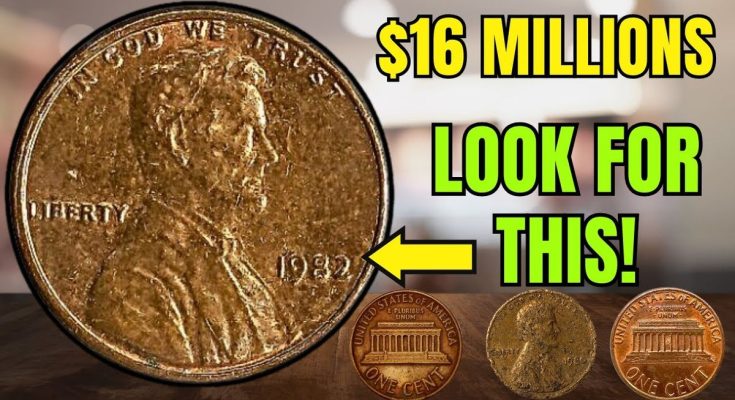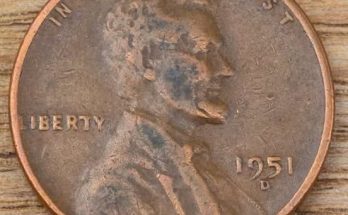Description
Imagine checking your spare change and realizing that one of your old copper pennies could make you a millionaire overnight. The image above, showing a close-up of a 1982 Lincoln Memorial penny, has sparked the curiosity of collectors and treasure hunters across the country. It boldly declares “$16 MILLIONS – LOOK FOR THIS!” and points to the year on the coin — 1982 — a date that holds special significance in U.S. coinage history.
The Lincoln Memorial cent, featuring Abraham Lincoln’s profile on the obverse and the Lincoln Memorial on the reverse, was produced from 1959 through 2008. For most people, these pennies are so common that they barely give them a second glance. But among these billions of coins, there are a few rare varieties that collectors will pay thousands, even tens of thousands, of dollars to obtain.
The year 1982 was a major turning point for the U.S. Mint. Because copper prices had risen sharply, it was becoming more expensive to produce one-cent coins made of solid copper. Until that year, pennies were composed of 95% copper and 5% zinc, giving them a heavier feel and a distinctive reddish-brown color. To save money, the Mint decided to switch to a cheaper composition: 97.5% zinc with only a thin copper plating. This new penny weighed noticeably less — about 2.5 grams compared to the old copper cent’s 3.11 grams.
However, the transition was not instant or simple. During 1982, the Mint struck both copper and zinc versions of the penny, as well as two different date designs — known as the Large Date and Small Date varieties. As a result, there are seven known types of 1982 Lincoln cents, and one extremely rare combination that has achieved almost legendary status among collectors: the 1982-D Small Date Copper Penny.
This coin is so rare because no copper pennies were supposed to be struck at the Denver Mint after the transition to zinc. Yet, somehow, a few copper planchets (blanks) were left in the machinery and used accidentally for the new Small Date dies. Only one confirmed specimen has been authenticated by experts, and it sold for a substantial amount — though not $16 million as many viral posts claim. Its value, depending on condition and market demand, could reach tens of thousands of dollars, possibly even more if another example were discovered.
So, how can you tell if you have a valuable 1982 penny? The first step is to check the weight. Use a precise digital scale:
-
If it weighs around 3.11 grams, it’s made of copper.
-
If it weighs around 2.5 grams, it’s zinc.
Next, look closely at the date. On a Small Date penny, the “2” in “1982” has a slightly higher and more delicate curve, and the “8” appears more even and rounded. On a Large Date penny, the “2” sits lower and the “8” looks more filled in. Collectors use magnifying lenses or coin photography to distinguish these differences.
If you happen to find a 1982-D Small Date penny that weighs 3.11 grams, you might have struck gold — or rather, copper worth its weight in gold! Before getting too excited, though, always have the coin verified by a reputable grading company such as PCGS or NGC. These professional services authenticate rare coins and issue a certification that guarantees their genuineness and grade, which is essential for serious buyers and auctions.
The fascination with rare Lincoln pennies extends beyond the 1982 series. Collectors also hunt for other famous varieties such as:
-
The 1943 Bronze Cent, accidentally struck on leftover copper planchets when pennies were supposed to be made of steel during World War II.
-
The 1955 Doubled Die Obverse, where the date and lettering appear doubled due to a die misalignment.
-
The 1969-S Doubled Die, another valuable error cent sought after by numismatists.
These rare coins remind us that extraordinary value can be hidden in plain sight. Millions of people handle pennies every day without realizing that one might be worth more than a luxury car or a college education. That’s why treasure hunters, metal detector enthusiasts, and everyday savers alike enjoy checking their change — just in case.
The viral claim in the image — that a 1982 penny could be worth $16 million — is exaggerated, but it captures the thrill of discovery that drives the hobby of coin collecting. Realistically, no Lincoln Memorial penny has sold for that much, yet genuine rare varieties have fetched five- or six-figure prices at auction. Even modest errors, such as off-center strikes or doubled dies, can bring $50 to several hundred dollars.
Ultimately, the message is clear: look carefully at your coins. The Lincoln cent, with its simple yet iconic design, has been part of American life for over a century. And within that long history lie fascinating stories of minting changes, mistakes, and accidental rarities that have turned ordinary pocket change into extraordinary finds.
So next time you come across an old penny from 1982, don’t toss it aside. Grab a magnifying glass, check its weight, and study the date style. You never know — you might just be holding a piece of numismatic history, and while it might not instantly make you a millionaire, it could certainly bring a small fortune and a great story to tell.



